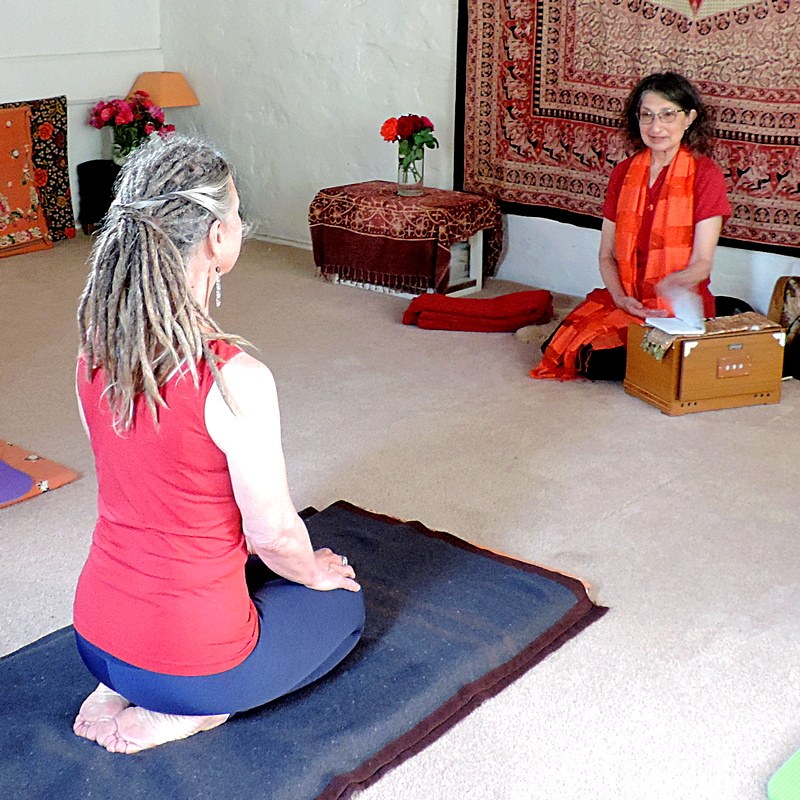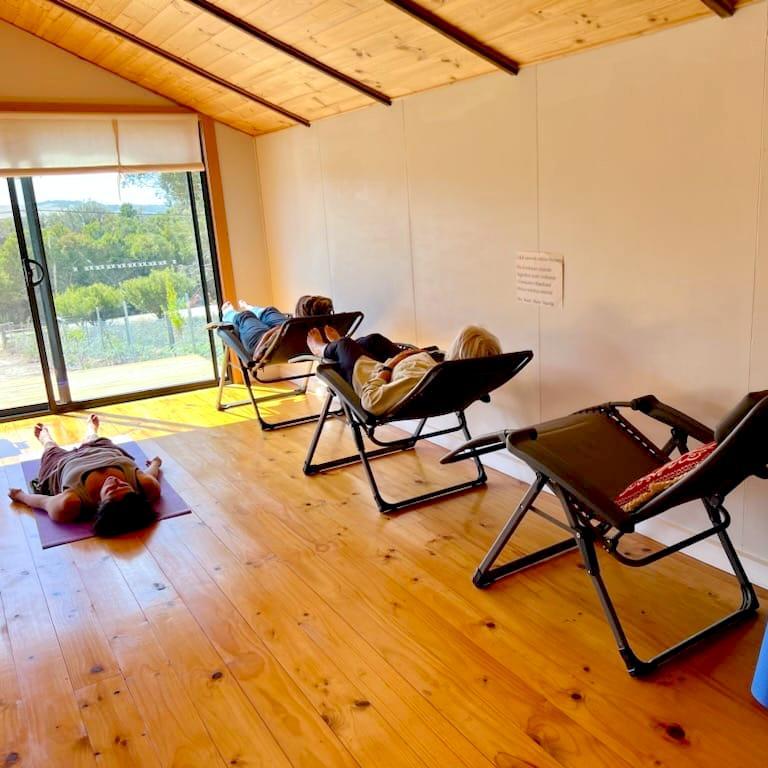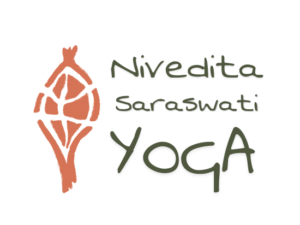Classes
Classes held Online and in person classes held in the Adelaide Hills. Nivedita also holds in person classes, retreats and workshops at Simplicity by the Sea, Killiecrankie, Flinders Island, Tasmania at various times of the year.
Class Formats
Group sessions and private one-on-one sessions available.
Class Levels
- Restorative
- Progressive
- Intermediate
- Mantra and Meditation
Bookings and Fees

Term 4 (8 weeks): Sunday September 3 – Friday October 27
- Restorative $145; (casual $20).
- Progressive $145; (casual $20).
- Mantra and Meditation $145; (casual $20).
- Intermediate $160; (causual $25).
- Second course discount $20: (casual $20).
- Yoga Nidra: $145; (casual $20).
- Private Session: $75 per hour (+$10 for each extra person).
Pay by direct debit:
Bendigo Bank
Account name: S. N. Saraswati.
BSB: 633 108
Account No: 1145 39059

Nivedita's Classes
RESTORATIVE/ GENTLE:
- Introductory level– gentle systematic postures, breathing and deep relaxation practices, accent on body and breath awareness, improving health & relaxation.
- Excellent for back care, boosting the immune system & managing chronic pain.
PROGRESSIVE:
- Develops the techniques of asana, pranayama, Yoga Nidra – deep relaxation and meditation.
- Deepening the profound benefits from regular and extended practice.
INTERMEDIATE:
- Longer sessions, for those with some experience.
- Extended pranayama & meditation.
MANTRA :
- Especially for those with a regular asana, pranayama practice.
- Deepening the experience of mantra, music & meditation.
“The yogis noticed that mantras were beneficial for managing the obsessive quality of the mind, the quality of chinta, worry or brooding, which limits one’s potential and creativity. The practice of mantra helps the mind come out of this state. In fact, even in the most stressful situation or environment it is possible to become relaxed with the use of the mantra”.
MEDITATION:
- Seated practice, develop focus & awareness/ insight into repetitive thinking patterns.
- Gentle breath techniques to support balance in the nervous system.
- Gentle movement to support release of physical tensions.
- Suitable for all levels of health & experience.
Here are just some of the benefits of meditation:
- Learn to manage negative emotions better.
- Increase mindfulness and learn to be present.
- Increased self-awareness.
- Increase imagination and creativity.
- Build patience and tolerance.
- Reduce stress and anxiety.
- Improve your attention span.
- Improve your memory and learning capabilities.
- Improve your sleep and
- Learn how to cope better with pain.
YOGA NIDRA:
Yoga Nidra: The Power of Conscious Sleep
This practice includes a wide range of benefits for example:
Body: helps prevent stress and stress-related disorders by inducing deep physical and mental relaxation
Mind: helps alleviate anxiety, hostility, insomnia and psychosomatic elements of eg asthma, coronary heart disease, cancer, & hypertension.
Learning: awakens inherent creativity, promotes learning & memory
Performance: visualize optimal outcomes, Improve motivation, self-awareness & self-acceptance.
Sense of Purpose: Finding a resolve, fostering positive habit patterns.
Information for Participants
- A medical information form must be filled in before your first session.
- Benefits enhanced by regular weekly sessions.
- Please do not strain with any of the practices. If you have any pain or difficulty please stop and let Nivedita know.
There are many variations and alternatives available. - Avoid eating before class.
- Arrive a few minutes early to settle yourself.
- Please do turn off mobile phones, remove shoes, leave bags in hall, cover mat.
- Please avoid wearing scented or metal items, personal conversations and coming when unwell.
- Finalise fees at or before 1st class.
- Direct deposit bring copy of receipt to first class.
- Please notify if unable to attend.
- Casual classes, phone each week to confirm space.
Class Types
Pawanmuktasana Series
“This series lays a firm foundation for the perfection of yoga asanas. The practices open up all the major joints and relax the muscles of the body. In Sanskrit, the word pawan means ‘wind’ or ‘prana’, mukta means ‘release’ and asana means ‘pose’. Therefore, pawanmuktasana means a group of asanas that remove any blockages preventing the free flow of energy in the body and the mind. These asanas promote total health, regulating and stabilizing the flow of energy in the body. Regular practice of Pawanmuktasana 1, 2 and 3 over a period of months brings about a profound relaxation and toning of the entire psycho-physiological structure which is necessary for the practice of advanced techniques (Swami Satyananda Saraswati 2008 Asana Pranayama Mudra Bandha, Yoga Publications Trust, Munger, Bihar, India).
Pawanmuktasana Part 1 – Anti-Rheumatic Group
This group is excellent for loosening up the joints and is beneficial for those debilitated by rheumatism, arthritis, high blood pressure or heart problems. These asanas are particularly useful for eliminating energy blockages in the joints and for improving co-ordination, self-awareness and self-confidence.
Pawanmuktasana Part 2 – Digestive/Abdominal Group
This group of asanas strengthens the digestive system. These asanas are beneficial for people with indigestion, constipation, acidity, excess wind or gas, lack of appetite, diabetes, disorders of the male or female reproductive systems and varicose veins. They also eliminate energy blockages in the abdominal area. These practices are not suitable for people suffering from high blood pressure, serious heart conditions, and back conditions such as sciatica and slipped disc or soon after abdominal surgery.
Pawanmuktasana Part 3 – Shakti Bandha Asanas (Energy Block Postures)
This group of asanas works to improve the energy flow within the body and break down neuro-muscular knots. These asanas also eliminate energy blockages in the spine, activate the heart and lungs, and improve the endocrine function. They are useful for those with stiff backs and are especially beneficial for menstrual problems and toning the pelvic organs and muscles. They can be practiced after pregnancy for toning flaccid muscles.”
~ Swami Satyananda Saraswati~
2008 Asana Pranayama Mudra Bandha, Yoga Publications Trust, Munger, Bihar, India.
Kirtan is the Sanskrit term for chanting, one of the traditional Indian yoga practices. In Kirtan Yoga, chanting is accompanied by classical Indian instruments such as the harmonium, while Sanskrit mantras are repeated using call and response, stilling the mind and opening the heart.
Singing is inherent within everyone who has the ability to make sound – no matter whether it’s tuneful or not! The background of singing is so ancient that it pre-dates any recorded history and was used long before formalised speaking. A voice that sings allows expression to flow, and emotion to be released, which is perhaps why we need this aspect of yoga now more than ever in the modern day world.
The various chants sung together or mantras uttered alone, could be thought of as ‘medicine for the soul’, as the word mantra is made up of two halves; man, the root of manas, meaning ‘mind’, and tra, meaning vehicle or instrument, referring to a chant’s ability to transport the mind from one state to another. When we chant in a group, music’s ability to bring people together allows the energy of the whole room to be transported to another level.
The word kirtan, or kirtana, means ‘telling, narrating, enumerating or describing’ and originates from the Vedic period, where it was first written as anukirtana or anukriti, meaning a ‘re-telling’. These anukirtanas would re-tell the ancient vedic hymns and passages. As was the way with the ancient world, everything was transmitted orally via spoken Sanskrit until the Vedas (knowledge) were written down by sages and scholars. The root word kirt, can be found in these ancient Vedic texts and is also known to go by the name sankirtana, meaning ‘collective performance’. Kirtan is an important aspect of yoga and one which holds so much potential for awakening and transformation.
~EkhartYoga~
Yoga nidra, also known as ‘psychic sleep’, is a deep relaxation practice from the Indian yoga tradition.
Yoga nidra is a state in which the body is completely relaxed, and the practitioner becomes systematically and increasingly aware of the inner world by following a set of verbal instructions. This state of consciousness is different from meditation, in which concentration on a single focus is required. In yoga nidra the practitioner remains in a state of light withdrawal of the 5 senses (pratyahara) with four senses internalised, that is, withdrawn, and only hearing still connects to any instructions given. The goals of both yogic paths, yoga nidra and meditation are the same, a state of meditative consciousness called samadhi.
Yoga nidra works with the autonomic nervous system. The autonomic nervous system regulates processes of the body that take place without a conscious effort (heartbeat, breathing, digestion and blood flow). This system also includes the sympathetic and parasympathetic nervous systems.
There’s such a benefit when those are balanced overall for immunity, digestion and stress management. But in this deeper relaxation, the pineal gland is activated and that releases the hormone melatonin.”
Melatonin is a powerful antioxidant. It can also help manage immune function, blood pressure, cortisol levels and induce restful sleep.
~Cleveland Clinic~
